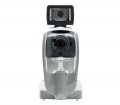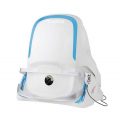-
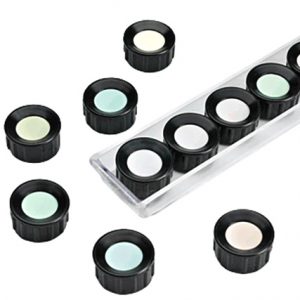 Anthony 15 Hue-Test Desaturated Test revels color blindness by using light hues. Diagnoses abnormal congentia, trichromats, and dyschromatopsia.
Anthony 15 Hue-Test Desaturated Test revels color blindness by using light hues. Diagnoses abnormal congentia, trichromats, and dyschromatopsia. -
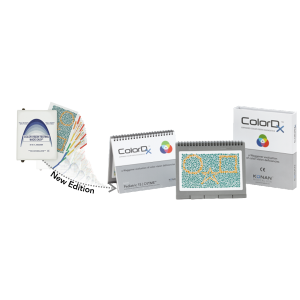 Same great test, but in a new and improved package! The ColorDx Pediatric 15 is the newest version of Color Vision Testing Made Easy or CVTME. As the Gold Standard pediatric assessment of color deficiencies or color blindness See The Multi-Ethnic Pediatric Eye Disease Study published by the AAO, CVTME™ is used in over 40 countries and has been validated for illiterates at the US Special Olympics. Featuring the proven Waggoner six confusion-color strategy, the pediatric test is used in a broad range of settings: pediatrics, eye physicians, school nurses, and many other disciplines of health care, in any language, world-wide. This easy to administer test features both hidden and non-hidden shapes that allow for positive reinforcement even while testing color deficient children by allowing successful answers on most targets. This success-reinforced strategy is also useful for assessment of malingering. Designed by color vision expert Dr. Terrace Waggoner, this new edition features enhanced digital colorimetery production methods, durable page and binding materials, and magnetic light-protective storage case and enhanced digital colorimetery production method and durable page materials and binding. Brilliantly simple to take, easy to score and just plain fun for children.
Same great test, but in a new and improved package! The ColorDx Pediatric 15 is the newest version of Color Vision Testing Made Easy or CVTME. As the Gold Standard pediatric assessment of color deficiencies or color blindness See The Multi-Ethnic Pediatric Eye Disease Study published by the AAO, CVTME™ is used in over 40 countries and has been validated for illiterates at the US Special Olympics. Featuring the proven Waggoner six confusion-color strategy, the pediatric test is used in a broad range of settings: pediatrics, eye physicians, school nurses, and many other disciplines of health care, in any language, world-wide. This easy to administer test features both hidden and non-hidden shapes that allow for positive reinforcement even while testing color deficient children by allowing successful answers on most targets. This success-reinforced strategy is also useful for assessment of malingering. Designed by color vision expert Dr. Terrace Waggoner, this new edition features enhanced digital colorimetery production methods, durable page and binding materials, and magnetic light-protective storage case and enhanced digital colorimetery production method and durable page materials and binding. Brilliantly simple to take, easy to score and just plain fun for children. -
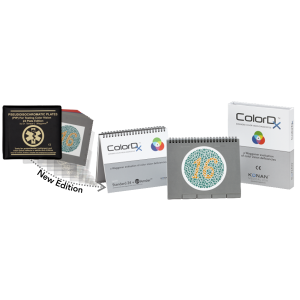 Same great test as before, but with a new and improved package! One of only two color vision tests validated and required for Naval Aviators. ColorDx is new brand identity for the proven Waggoner six confusion-color strategy used by physicians, Ophthalmologists, Optometrists, and nurses worldwide. This military grade test is used by the US Army and for FAA annual flight physicals requiring color vision testing and has been independently validated by both academic institutions and military services. This new edition features enhanced digital colorimetery production methods, durable page and binding materials, and magnetic light-protective storage case. The ColorDx Standard 24 is designed and licensed from color vision expert Dr. Terrace Waggoner and is the newest edition of the Waggoner PIP-24 (PIPIC 24).
Same great test as before, but with a new and improved package! One of only two color vision tests validated and required for Naval Aviators. ColorDx is new brand identity for the proven Waggoner six confusion-color strategy used by physicians, Ophthalmologists, Optometrists, and nurses worldwide. This military grade test is used by the US Army and for FAA annual flight physicals requiring color vision testing and has been independently validated by both academic institutions and military services. This new edition features enhanced digital colorimetery production methods, durable page and binding materials, and magnetic light-protective storage case. The ColorDx Standard 24 is designed and licensed from color vision expert Dr. Terrace Waggoner and is the newest edition of the Waggoner PIP-24 (PIPIC 24). -
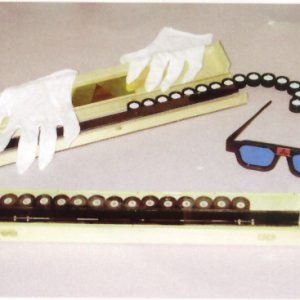 Combined D-15 Test Similar test to the Anthony and Farnsworth. Box contains 16 caps with different colored papers attached. The unique feature is that the box is designed to shorten test time. When raised, the caps can easily slide out one end that raises with the top. Then, the patient inserts the caps, the box is closed, and the box turned over revealing a clear bottom through which to score the selections. Item #: G15130
Combined D-15 Test Similar test to the Anthony and Farnsworth. Box contains 16 caps with different colored papers attached. The unique feature is that the box is designed to shorten test time. When raised, the caps can easily slide out one end that raises with the top. Then, the patient inserts the caps, the box is closed, and the box turned over revealing a clear bottom through which to score the selections. Item #: G15130 -
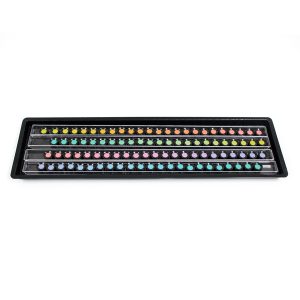 This handheld circular pupillometer device is used for measuring different size pupils. It was developed and researched by Dr. Jack Richman, O.D., as part of the Massachusetts Drug Evaluation and Classification Program (MDEP). This pupil measurement device is used by law enforcement officers across the country to assist in determining whether people are possibly impaired and/or under the influence of drugs. The reverse side has expected pupil size in different lighting conditions for non-impaired people. Item #: LV3553000
This handheld circular pupillometer device is used for measuring different size pupils. It was developed and researched by Dr. Jack Richman, O.D., as part of the Massachusetts Drug Evaluation and Classification Program (MDEP). This pupil measurement device is used by law enforcement officers across the country to assist in determining whether people are possibly impaired and/or under the influence of drugs. The reverse side has expected pupil size in different lighting conditions for non-impaired people. Item #: LV3553000 -
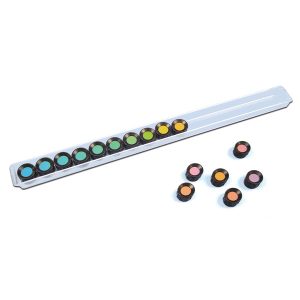 Farnsworth D15 Dichotomous Color Test Farnsworth Test for Congenital and Acquired color defects. The Farnsworth D-15 contains a reference disc holding notation 10 B 5 4 and fifteen numbered discs which make up an incomplete color circle. The patient arranges the discs and then evaluation of the patients arrangement separates 'normal' color perception from moderate and strong defects in deutan, protan or tritan axis color discrimination. The D-15 is housed in a plexiglass container. the disks are spread out on a table and arranged by the patient. The Farnsworth D-15 test is a subset of the well known Farnsworth 100 Hue Test. It is intended for classification instead of in-depth study of color vision defects. The D-15 and 100 hue tests are correlated. Growing Importance of Color deficiency Screening. In addition to congenital color deficiency screening there is growing evidence that adult acquired color deficiency, especially in yellow and blue perception, can indicate medical toxicity and other problems. Increasingly complex security and medical systems also require verification of all three types of color receptors. How the D-15 test works: The Farnsworth D15 is called 'dichotomous' because it is designed to separate subjects into one of two groups, 1) Strongly color deficient or 2) Mildly color deficient or color normal. This is accomplished by the arrangement of vivid (saturated) colored discs. A perfect score shows normal color perception. A non-perfect score is used to determine a medium or strong color deficiency.
Farnsworth D15 Dichotomous Color Test Farnsworth Test for Congenital and Acquired color defects. The Farnsworth D-15 contains a reference disc holding notation 10 B 5 4 and fifteen numbered discs which make up an incomplete color circle. The patient arranges the discs and then evaluation of the patients arrangement separates 'normal' color perception from moderate and strong defects in deutan, protan or tritan axis color discrimination. The D-15 is housed in a plexiglass container. the disks are spread out on a table and arranged by the patient. The Farnsworth D-15 test is a subset of the well known Farnsworth 100 Hue Test. It is intended for classification instead of in-depth study of color vision defects. The D-15 and 100 hue tests are correlated. Growing Importance of Color deficiency Screening. In addition to congenital color deficiency screening there is growing evidence that adult acquired color deficiency, especially in yellow and blue perception, can indicate medical toxicity and other problems. Increasingly complex security and medical systems also require verification of all three types of color receptors. How the D-15 test works: The Farnsworth D15 is called 'dichotomous' because it is designed to separate subjects into one of two groups, 1) Strongly color deficient or 2) Mildly color deficient or color normal. This is accomplished by the arrangement of vivid (saturated) colored discs. A perfect score shows normal color perception. A non-perfect score is used to determine a medium or strong color deficiency. -
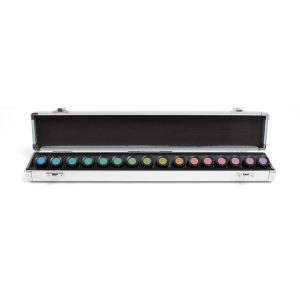 Farnsworth Test for Congenital and Acquired color defects. The Farnsworth D-15 contains a reference disc holding notation 10 B 5 4 and fifteen numbered discs which make up an incomplete color circle. The patient arranges the discs and then evaluation of the patients arrangement separates 'normal' color perception from moderate and strong defects in deutan, protan or tritan axis color discrimination. The disks are spread out on a table and arranged by the patient. The Farnsworth D-15 test is a subset of the well known Farnsworth 100 Hue Test. It is intended for classification instead of in-depth study of color vision defects. The D-15 and 100 hue tests are correlated. Growing Importance of Color deficiency Screening: In addition to congenital color deficiency screening there is growing evidence that adult acquired color deficiency, especially in yellow and blue perception, can indicate medical toxicity and other problems. Increasingly complex security and medical systems also require verification of all three types of color receptors. How the D-15 test works: The Farnsworth D15 is called 'dichotomous' because it is designed to separate subjects into one of two groups, 1) Strongly color deficient or 2) Mildly color deficient or color normal. This is accomplished by the arrangement of vivid (saturated) colored discs. A perfect score shows normal color perception. A non-perfect score is used to determine a medium or strong color deficiency.
Farnsworth Test for Congenital and Acquired color defects. The Farnsworth D-15 contains a reference disc holding notation 10 B 5 4 and fifteen numbered discs which make up an incomplete color circle. The patient arranges the discs and then evaluation of the patients arrangement separates 'normal' color perception from moderate and strong defects in deutan, protan or tritan axis color discrimination. The disks are spread out on a table and arranged by the patient. The Farnsworth D-15 test is a subset of the well known Farnsworth 100 Hue Test. It is intended for classification instead of in-depth study of color vision defects. The D-15 and 100 hue tests are correlated. Growing Importance of Color deficiency Screening: In addition to congenital color deficiency screening there is growing evidence that adult acquired color deficiency, especially in yellow and blue perception, can indicate medical toxicity and other problems. Increasingly complex security and medical systems also require verification of all three types of color receptors. How the D-15 test works: The Farnsworth D15 is called 'dichotomous' because it is designed to separate subjects into one of two groups, 1) Strongly color deficient or 2) Mildly color deficient or color normal. This is accomplished by the arrangement of vivid (saturated) colored discs. A perfect score shows normal color perception. A non-perfect score is used to determine a medium or strong color deficiency. -
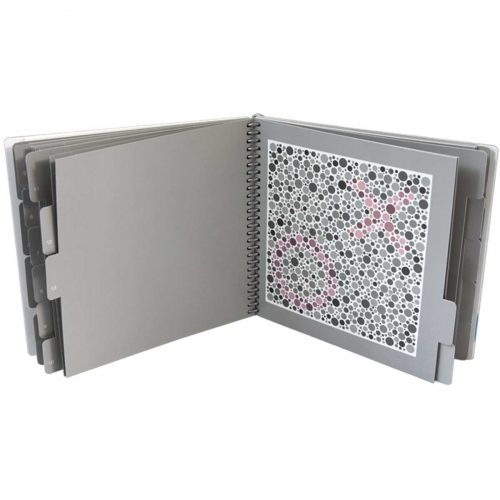 730006 The HRR (Hardy Rand and Rittler) Standard Pseudoisochromatic Test, 4th Edition provides several very important features to provide the most advanced color vision test available: congenital and acquired testing, identification of the type of defect, and diagnosis of the extent of the defect as well as quick positive classification of normals. The HRR employs a sophisticated test strategy that virtually eliminates the potential for memorization and malingering. The figures used by the HRR Pseudoisochromatic Plates are independent of language and suitable for both adults and children.
730006 The HRR (Hardy Rand and Rittler) Standard Pseudoisochromatic Test, 4th Edition provides several very important features to provide the most advanced color vision test available: congenital and acquired testing, identification of the type of defect, and diagnosis of the extent of the defect as well as quick positive classification of normals. The HRR employs a sophisticated test strategy that virtually eliminates the potential for memorization and malingering. The figures used by the HRR Pseudoisochromatic Plates are independent of language and suitable for both adults and children. -
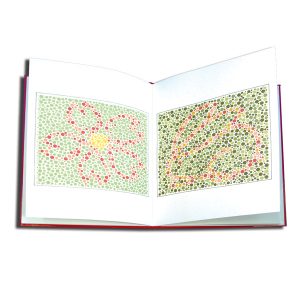 This test is similar to the Ishihara Isochromatic Test. 10 plates with non-verbal animal patterns. Originally created by Hiro Matsubara, MD. Printed in Japan. Item #: AT400
This test is similar to the Ishihara Isochromatic Test. 10 plates with non-verbal animal patterns. Originally created by Hiro Matsubara, MD. Printed in Japan. Item #: AT400 -
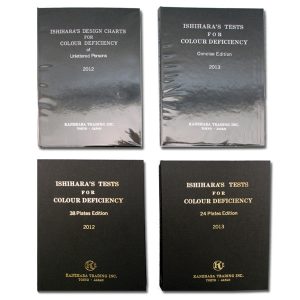
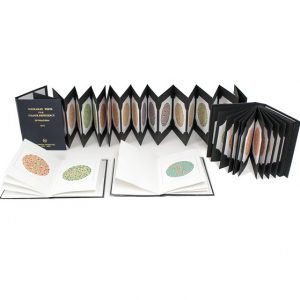 Ishihara Pseudo-Isochromatic Test The most widely used standard of color vision screening in a book form. Instructions Included.
Ishihara Pseudo-Isochromatic Test The most widely used standard of color vision screening in a book form. Instructions Included. -
 730005 The Laminated HRR (Hardy Rand and Rittler) Pseudoisochromatic Test, 4th Edition provides several very important features to provide the most advanced color vision test available: congenital and acquired testing, identification of the type of defect, and diagnosis of the extent of the defect as well as quick positive classification of normals. The HRR employs a sophisticated test strategy that virtually eliminates the potential for memorization and malingering. The figures used by the HRR Pseudoisochromatic Plates are independent of language and suitable for both adults and children.
730005 The Laminated HRR (Hardy Rand and Rittler) Pseudoisochromatic Test, 4th Edition provides several very important features to provide the most advanced color vision test available: congenital and acquired testing, identification of the type of defect, and diagnosis of the extent of the defect as well as quick positive classification of normals. The HRR employs a sophisticated test strategy that virtually eliminates the potential for memorization and malingering. The figures used by the HRR Pseudoisochromatic Plates are independent of language and suitable for both adults and children. -
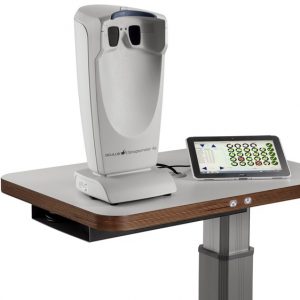
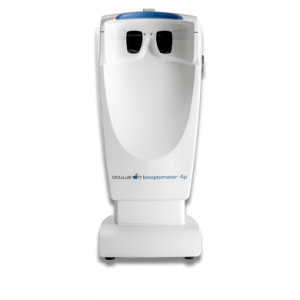 The OCULUS Binoptometer® 4P is a professional screening instrument for testing all relevant visual functions. The used future-oriented technology allows an almost unlimited representation of various vision tests. Vision-screening instrument with contrast sensitivity testing and optional mesopic vision and glare sensitivity testing.
The OCULUS Binoptometer® 4P is a professional screening instrument for testing all relevant visual functions. The used future-oriented technology allows an almost unlimited representation of various vision tests. Vision-screening instrument with contrast sensitivity testing and optional mesopic vision and glare sensitivity testing.New Test Presentation
Vision tests are presented on a high-resolution micro-color display, allowing a virtually unlimited presentation of vision tests.Unbeatable
Contrast sensitivity, optional mesopic vision and glare sensitivity testing with just one instrument.Ergonomic
Convenient height adjustment range of 4.13 inch (10.5 cm). In addition, the viewing angle is fully adjustable up to a 35° downgaze, thus enabling testing to be done ergonomically with any eyeglasses.

